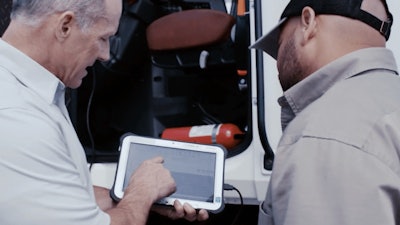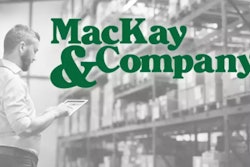
Truck dealerships clearly understand the importance of delivering on service promises. The best run dealerships are consistently able to meet those customer service goals.
Many have successfully implemented exceptional standard operating procedures (SOPs) across the entire service process that define timeframes for completion of initial diagnostics, and maintenance and repairs. The result is a more predictable level of service that enables customers to better plan their fleet operations based on equipment availability.
Carefully crafted SOPs are one of two key components behind these best practices. Designed to keep service activity on track through higher levels of consistency and control over operations, they provide a process for auditing compliance based on Key Performance Indicators (KPIs), and as a result promote accountability among personnel and between departments.
The second and equally important element, and what enables and improves adherence to SOPs, is advanced service and dealer management technology. The ability to successfully implement and manage practices that establish and streamline service are critically dependent on harnessing the functionality of those platforms.
[RELATED: Data tools can provide sales staff advantages]
Building SOPs around service and dealer management technology has a quantifiable return on investment for truck dealerships.
A case in point is the RWC Group, a Phoenix-based commercial truck and bus dealership providing sales and service for Hino, Isuzu, and International trucks at 14 locations in five states.
“Our focus on achieving and maintaining best practices is continual,” says Casey Scheirer, director of service at RWC Group. “We’re always talking about opportunities and areas of improvement. With SOPs and KPIs we’re able to manage and quantify how well we're following the process and identify areas where we need improvement.”
Using integrated service and dealer management technology across its operation has resulted in measurable benefits for RWC Group. Overall, cycle time for service from check-in to completion has dropped by 25%. Additionally, the ability to dive into factors impacting dwell time has resulted in a 77% reduction in time for check-in, and a six-hour improvement per service event.
[RELATED: Action plans for difficult customer parts and service requests]
Other benefits for RWC Group include administrative time savings from the ability to use as few systems as possible, avoiding the need to switch between multiple systems to access critical information. Workflow processes across its service management platform and an integration with the group’s DMS are driving consistent service practices and ensuring data accuracy.
Consolidated and well-established service and dealer management solutions also create efficiencies by enabling communication, both internally to streamline service, and with customers to proactively provide vehicle status updates.
Effective and well-established service and management systems elevate the value dealerships can deliver. That value is seen in the form of revenue returned to fleets (uptime) through a reduction in days out of service (downtime), and to service operations in steady and repeat business through improved bay and technician productivity (throughput).
“Utilizing the best technology available is vital,” says Keith Ely, founder and managing shareholder of KEA Advisors. “That’s why we have experts and expertise with major dealership management system (DMS), service management and CRM applications.”
[RELATED: KEA Advisors publishes new Dealership Performance Guides]
In his blog on Technology, a vital leg of the stool, Ely discussed how PPT (People, Processes, Technology) drives continuous improvement. Beyond making sure the right people are educated and knowledgeable about having updated and effective processes, he notes, equally important is having the right technology, and knowing how to apply it to achieve your desired results.
For example, service management technology enables you to identify potential bottlenecks and inefficiencies, a key to finding opportunities to implement best practices outlined in SOPs. Additionally, with a view into time intervals across service operations, between departments, locations, and timeframes, as well as within a single status event, there have been proven measurable benefits, including:
- An 11% to 24% improvement in return to service time for customer assets
- An average 5-hour reduction in time to complete check in
- An average 12-hour reduction in time for estimate approval and authorization
In recent surveys, more than 400 fleet members of the ATA’s Technology & Maintenance Council provided insight into their top maintenance challenges. Among them they included the reliability of service management technologies.
With proven technology, fleet managers and service providers can address that challenge. Driven by data to gain better insight into their operations, they can proactively implement SOPs that drive efficiency and profitability.
[RELATED: Parts, labor costs stabilizing, VMRS report says]
Some of the key characteristics of advanced service and dealer management technology include:
- By serving as a hub for connected vehicle and service event and history information, these platforms provide actionable, in-context information and data, at the point of service that reduces triage and diagnostic time, and speeds repairs. The result is a reduction in downtime, higher technician productivity and improved shop throughput, and lower costs for labor, overhead and administrative expenses.
- Predictive maintenance is enabled by using fault data and notifications to schedule repairs. Costly breakdowns can also be avoided when inspection and diagnostic information is used to proactively address service and repair needs.
The more consistent and effective use of service and dealer management technology and adherence to SOPs, particularly to foster more productive and persistent communication between dealers and fleet owners, the greater the benefit in technician and shop productivity and efficiency. The failure to use these solutions results in lost revenue, inefficiency, substandard customer service and ultimately puts service providers at a disadvantage.
It is well documented dealers who are focused on improving their service operations by using service and dealer management technology are realizing higher revenues. The future of profitable dealership service operations is largely dependent on their ability to embrace and successfully implement processes built on those platforms.











